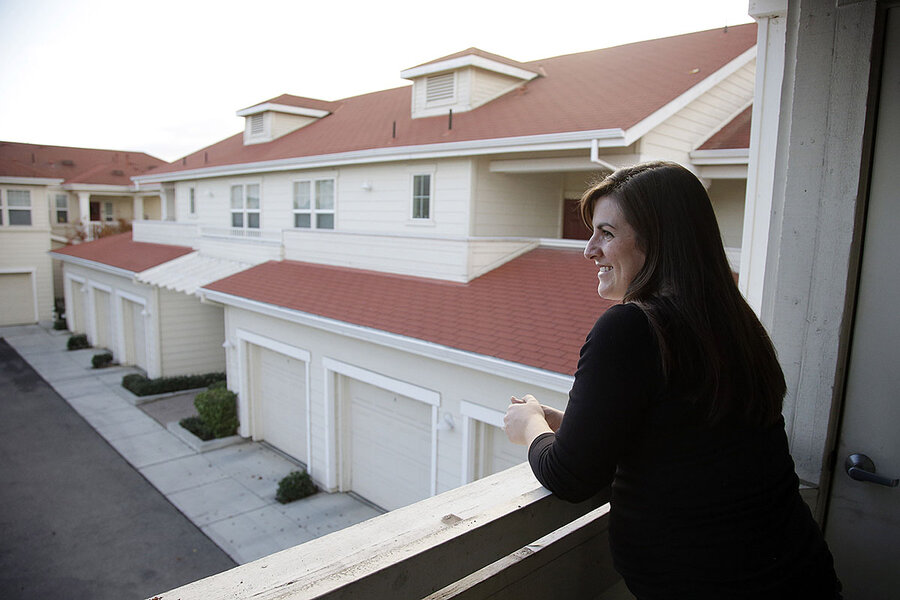Schools help teachers with a new kind of homework: finding a place to live
Loading...
| THOREAU AND GALLUP, N.M.
Taryn Perkins remembers searching for Thoreau, N.M. on a map.
Last summer, she and her husband were both offered teaching jobs there that seemed perfect, and the couple had always loved small, rural communities. But Thoreau seemed … really small and really rural.
“Where would we even live when we get there?” Ms. Perkins recalls thinking. The school district soon told Ms. Perkins and her husband about the teacherage: a neighborhood of small, affordable homes in Thoreau built exclusively for the town’s teachers.
Why We Wrote This
A year of teacher walkouts in the US has been forcing communities to face school underfunding and low pay. But some school districts are offering housing to attract and retain new teachers.
“We were ecstatic to find that out,” says Perkins. “It’s been a huge blessing.”
As school districts across the country struggle to recruit and retain teachers, many are also experimenting with different ways to help with housing – especially in rural districts, which typically have more staffing struggles. Thoreau, for example, a town of fewer than 2,000 people on the outskirts of the Navajo Nation, has cut teacher vacancies by almost 95 percent in the last few years by offering subsidized rent in the teacherage.
“We face odds that other districts just don’t face,” says Gerald Horacek, assistant superintendent of curriculum and instruction at Gallup McKinley County Schools, from his office in Gallup, N.M., the closest town to Thoreau, a 30-minute drive away. “How do you incentivize for qualified, quality teachers to go there when they can come here? You have to provide housing.”
A real incentive
Joanna Tulabing, a sixth-grade English teacher at Thoreau Middle School, sits on a bench in front of her house and draws an open palm across her body, as if she is presenting the winning prize on a game show.
“Three parking spots, a shed, and backyard,” she says, describing how her home was one of the main reasons she decided to move to Thoreau four years ago.
Ms. Tulabing and her husband pay $475 a month for their two-bedroom apartment, which comes with free utilities. It’s a great deal, says Tulabing, and it’s convenient: When the weather is nice, she can walk to work.
The teacherage plays a big part in encouraging teachers like Tulabing to come to – and stay in – places like Thoreau.
In 2016, Gallup McKinley started the school year with 120 vacancies on the first day of school. By 2018, that number had dropped to just 7, a change Mr. Horacek attributes to the teacherage.
And while the district is still one of the lowest performing in the country, it’s improving: 600 more students became proficient in math and reading last school year – the district’s greatest ever year-over-year growth. Gallup McKinley has offered forms of teacher housing since the 1960s, but the district attributes the recent success to, among other things, increased housing incentives such as free utilities and a few months of free rent.
“It’s good for us, it’s good for our kids,” says Horacek. “These things help the schools improve academically.”
Helping teachers stay in the profession
The average teacher salary is below the family living wage in more than half of US states, according to a study last year by Education Resources Strategies, and teachers in large, coastal cities can spend up to 70 percent of their income on rent – far above the recommended share of 30 percent. Largely because of these financial struggles, almost 20 percent of teachers leave the profession within their first five years of teaching, and thousands of classrooms face teacher vacancies each year. All of this affects students, who do better with less teacher turnover.
“I’ve interviewed hundreds of teachers over the years and a line that comes up is, ‘I never expected to get rich.... But now I’m not paid enough to be able to afford teaching anymore,’ ” says Susan Moore Johnson, an education professor at Harvard University and director of The Project on the Next Generation of Teachers, a group that focuses on recruiting and retaining a strong teacher force.
Some education experts say districts should just raise teachers’ salaries instead of putting money toward housing incentives. But in low-populated, rural districts such as Gallup McKinley, housing for teachers quite simply doesn’t exist. These districts see it as a tangible improvement they can make.
Several urban districts like San Francisco, where teachers are often priced out of living in the district, are also experimenting with alternative housing solutions for teachers. Dare County Schools, located in the Outer Banks of North Carolina, says its affordable teacher housing allowed the district to recruit enough teachers to build a foreign language program. The Miami-Dade school system in southern Florida is considering building residential complexes on school grounds, and a district in San Mateo County, Calif., plans to break ground on a 116-unit apartment building for teachers this year.
Housing or not, building a community for rural teachers can make a big difference for recruitment and retainment, says Robert Mahaffey, executive director of The Rural School and Community Trust in Alexandria, Va.
“The most important part of staffing schools in rural places is community-placed support for the school,” says Mr. Mahaffey. “If the teacher feels welcomed and engaged and a part of the community, [he or she] is more likely to stay.”
Tulabing never saw herself living in a place like Thoreau, but now she can’t imagine leaving. First, because of the home she made in the teacherage, and secondly, because of her colleagues – whom she also can call her neighbors.
“I thought it was going to be really difficult,” says Tulabing. “But when I came into this building and started to meet my colleagues … they are the friendliest people I have met.”






